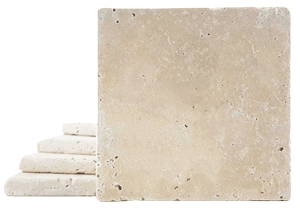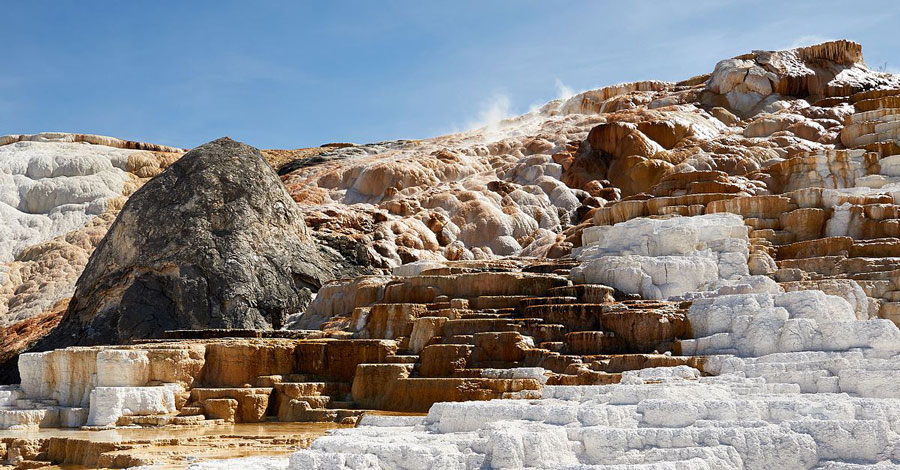
WHAT IS TRAVERTINE TILES AND ITS TYPES?
Travertine is a type of limestone formed by mineral deposits around hot springs or in caves. It's characterized by its distinctive holes and a warm, earthy colour palette. This natural stone has become a popular choice for both indoor and outdoor applications due to its unique beauty, affordability and durability.
Types of Travertine
The colour and veining of travertine can vary greatly depending on the mineral content and geological conditions of its formation. Here are some common types:
Ivory Travertine: Known for its soft, creamy white colour, Ivory Travertine is a classic choice for elegant and sophisticated spaces.
Classic Travertine: This type offers a warm, beige hue with subtle veining, providing a versatile option for various design styles.
Noce Travertine: Characterized by its rich, brown tones, Noce Travertine adds a touch of rustic charm and warmth to any space.
Silver Travertine: This variation features a light grey or silver base with delicate veining, creating a contemporary and sophisticated look.
Where Does Travertine Come From?
While travertine can be found in various regions worldwide, some of the most renowned sources include:
Italy: Italian travertine, particularly from the Tuscany region, is celebrated for its high quality and distinctive veining.
Turkey: Turkish travertine, especially from the Denizli province, is known for its wide range of colours and affordability.
Mexico: Mexican travertine offers a unique blend of warm tones and durability.
Iran: Iranian travertine is often characterized by its rich colour variations and intricate veining patterns.
It’s essential to consider the origin of travertine when making a purchase, as it can influence the stone’s quality, colour consistency, and overall price. It is our belief that the best value for money travertine originates in Turkey.
Why is Travertine Popular?
Travertine has been a popular architectural stone for thousands of years. You can see travertine used at the Colosseum in Rome (the largest travertine building in the world) and at the Basilique Du Sacre Coeur in Paris.
Nowadays, travertine is highly sought after to create a premium tiling look or stone facade. Its subtle warm texture and premium lustre make it complementary for a variety of residential and commercial styles. Moreover, the stone colours range from silver, grey to gold and rust hues.
As well as its good looks, travertine is an incredibly durable stone. In modern architecture, travertine is one of the most popular stones used.
Travertine has many practical properties that make it a versatile building material.


Why Travertine is Great For Your Home…
- Travertine tiles don’t absorb large amounts of heat. As a result, this makes it an ideal paving solution for pool tiles or anywhere you may have uncovered outdoors especially in hot weather.
- No two travertine stone tiles or pavers look the same. Therefore, you can create a truly unique look in your home or backyard area.
- Travertine stone tiles are durable and reliable to last the test of time. Unlike cheap looking porcelain tiles which chip very easily.
- They are easy to maintain. We recommend applying a sealer once they’re laid over the surface for extra peace of mind.
- Many of the natural tones in travertine have a warm, classic texture and look which is timeless and transitional for both modern and traditional homes
Travertine has a distinct texture compromising of sporadic holes and voids. However, you can choose to fill the empty spaces with grout to achieve a smoother surface or get the stone honed and filled for a completely smooth surface. We recommend that this is appropriate for indoor applications such as bathroom or kitchen tiling. Additionally, this makes the tiles easier to sweep clean indoors.
Travertine comes in a variety of finishes:
Honed
The surface of the travertine has been ground to a completely flat, smooth surface.
Honed and unfilled
The surface has been ground flat and the imperfections and holes have been left unfilled.
Honed and filled
The surface is ground flat and the imperfections and holes have been filled. This style is ideal for indoor applications such as the kitchen as spillage and dirt can be easily swept on the smooth surface without getting caught up in holes and voids.
Tumbled and unfilled
The travertine stone is in its natural state with rough edges and holes exposed. This look is ideal to create an antiqued look in an outdoor garden area or patio as well as a decorative feature wall.
Travertine Quality Guarantee
Absolutely no man made fillers or cheap substitutes in any of our travertine. Our product is pure high quality travertine in its most natural form.
As a commitment to quality, our stone experts directly deal with the best quarries in the world. This is to ensure you get the best quality travertine.
All our products meet stringent standards for residential and commercial use in Australia and New Zealand.




